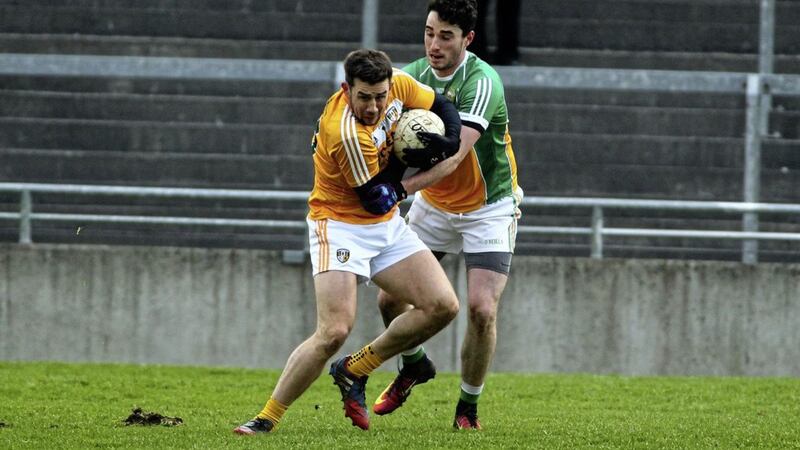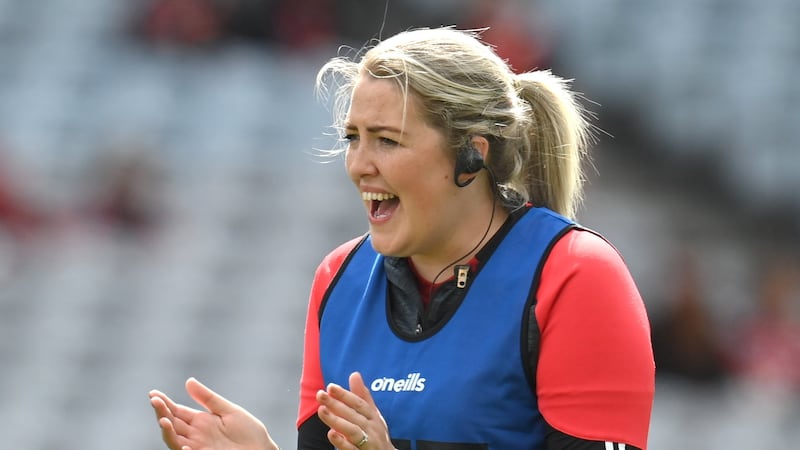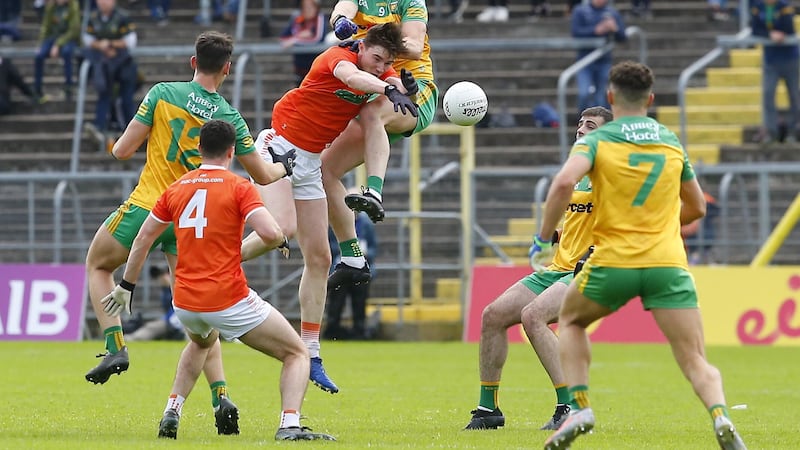TWELVE months standing watching Antrim has given Conor Murray plenty of thinking time.
While he was recovering from a torn cruciate knee ligament suffered against Offaly last June, the Lámh Dhearg man remained a familiar face at the county’s football fixtures in Corrigan Park, where he’d pull on the brown Maor Uisce bib.
It allowed him to patrol the far line from Lenny Harbinson. Allowed him to feel part of it.
Management gently implored him to travel to the away league games, though that was just a bridge too far. Sticking around for those home games and showing his face at training through his whole rehab, though, are largely the reasons why he was back in the Saffron against Louth last weekend.
“Because Ryan [his brother] was playing and it’s always the chat in our house, I still wanted to be part of it when we had home games.
“I never really distanced myself, even when I was out I was still going to training once or twice a week to see the physio and show my face.
“I just felt if I’d let go, I probably wouldn’t have come back. If I’d taken a break for a few months, I might have went ‘ah, I feel out of it now’.
“So I kept in touch the whole year through.”
He passed all the tests and was back in full training the week before they played Tyrone, but that was just too soon. Instead his return came as a half-time sub in Darver, where two Matthew Fitzpatrick goals helped Antrim overcome Louth.
It was their first championship since they stunned Laois in a first round qualifier in 2015.
By Murray’s estimate of “a minimum of four nights a week since October”, with short breaks at Christmas and Easter, Antrim have trained somewhere in the region of 120 times this season.
“It was a long time coming for a group of six or seven of us that have been about since the last one.
“To get a win in the championship makes it feel like all those nights are worthwhile.”
Whatever comes to pass against Kildare in Corrigan Park on Saturday afternoon, it’s become about more than win or lose. It’s about what the game can do for football in Antrim, and in particular Belfast.
When he thinks of the problems that need fixed, Murray’s mind is drawn back to the 2006 Ulster minor final in which he played when Antrim were beaten by Donegal in Croke Park.
“That team should have been brought on to senior level and pushed, a strength and conditioning programme in place, that sort of stuff. But it’s happening a lot.
“There are players there drifting away. Of that minor team, there are probably only three or four even playing Gaelic at club level.”
He’d schooled at De La Salle in west Belfast, where he won a MacLarnon Cup. But in terms of involvement in MacRory Cups, it’s now 33 years since a city side won it, and between St Mary’s and St Malachy’s they’ve won all four that Belfast’s ever brought home.
“La Salle is predominantly a soccer school. We had a very good Gaelic team, we won the MacLarnon.
“But the only time I was really exposed to top-level Gaelic was going to university, where the likes of whoever was playing MacRory football for Omagh CBS or St Colman’s Newry, they’re playing ‘A’ football the whole way up.
“It needs to start in schools. Realistically there’s nobody in Belfast or Antrim that will be competing for MacRory Cups. The odd school might enter in and out like St Louis’ Ballymena or St Mary’s CBGS on the Glen Road, but they’re never going to win the MacRory.”
When he left La Salle, Murray went on to study at Jordanstown, doing sports science and then a PGCE in PE.
He played a bit of Sigerson football when he was there, and that in itself has become a huge rarity for Antrim footballers.
Queen’s had two Antrim players on their team this year. St Mary’s and Jordanstown both had none, though there was one in the NUI Galway side and Peter Healy has done well with UCD.
Perhaps that paints the picture as well as anything.
“I’ve loads of friends who are better athletes than me, but they’ve chosen soccer over Gaelic when it’s come to their teenage years.
“We’re not getting that exposure until we hit Freshers football at university. Getting the kids exposed to top-level football as early as possible is what you want.
“There aren’t many people from Antrim playing Sigerson football. Look at the teams, Jordanstown, Queen’s, St Mary’s, there’s maybe only one or two Antrim players on those teams, even though we have one of the biggest student populations in Belfast.”
Murray talks about St Enda’s run to the All-Ireland intermediate final and how there’s a core of interest around Glengormley and other areas of north Belfast, but that the infrastructure around them isn’t strong enough to allow the game to properly flourish in the face of competing sporting interests.
“I don’t know how many development officers there are in Antrim compared to other counties. There isn’t enough resources for the population.
“In north Belfast, they’re big into Gaelic, there are some big clubs – but there just isn’t the provision in that part of the city. It is getting better.
“But the population that there is in Belfast, GAA is still not the forefront sport that you want to be involved in. Soccer’s still taking over in those communities.
“There are so many clubs in Antrim, but the majority of the clubs in north Antrim are all hurling – is there any way football can be pushed in that part of the county?
“There is the population. Look at Monaghan, they have the same population as Andersonstown. They’re competing in Division One, Super 8s – how are they able to do that? We have a population five times the size in Belfast.”
* * * * * * * * *
TURNED 30, he is due to become a father-of-four at Christmas. Roma (7), Jude (3) and Fiadh (1) will have another little sibling.
His wife Laura’s understanding hands are full. He admits to getting a bad look when he broke the news that he intended to return to the Antrim setup after doing his knee.
Murray has previously spoken of his desire to play for Antrim until they tell him not to come back. That enthusiasm was boundless in his early days, when he joined under Liam Bradley. There was an Ulster final, Division Two finals and a championship win over Galway to come in the following few seasons.
But it was never built on, and as he now assumes veteran status, the annual turnover of players has become a huge barrier to their hopes of proper progression.
“The main thing is Antrim needs to be playing Division Two football, staying there for three or four seasons, making Ulster semi-finals regularly and a final every few years, maybe go on a run in the qualifiers and get to an All-Ireland quarter-final.
“That’s the sort of stuff needs to happen for the next wave of people to come. If you look at that Dublin team, they maybe just add in two or three players every season and keep doing that.
”We’re either bringing in a brand new team – there were so many debutants against Tyrone – or we’re going back to the people who have been there before.
“We’re stuck in a limbo where we don’t have a set panel that we could bring the odd U20 or a very good minor into every season.”
Saturday sees them bring Kildare into Corrigan Park. If John Horan has his way, defeat would make it Antrim’s last championship game against a top-end side until they climb two divisions in the National League.
Murray says the sheer volume of work put in by players for very little current reward means something has to change.
“There’s definitely a need for something. Say Louth had beaten us, we’d have been training for almost a full year to play the league and two games in the championship.
“We all know we’re not going to win Sam Maguire, but the GAA need to go about it the right way.
“The Tommy Murphy Cup, I played in that. It wasn’t given the same recognition as the Sam Maguire.
“Even though it’s not at as high a level, it needs to be played the same weekends, semi-finals and final need to be played in Croke, there needs to be an Allstar team for the second tier and they play against the ‘A’ Allstar team.
“That’s the main thing people want. Some counties will say they don’t want a tiered championship because they want to compete against Tyrone, Dublin, Donegal.
“That’s fair enough, but if you’re going to be getting constantly beat every year, there needs to be something at the end of the tunnel, an incentive to play in it.
“The players want the recognition and respect from Croke Park and the GAA – that it’s not just played to get us out of the way and concentrate on the big counties.”








